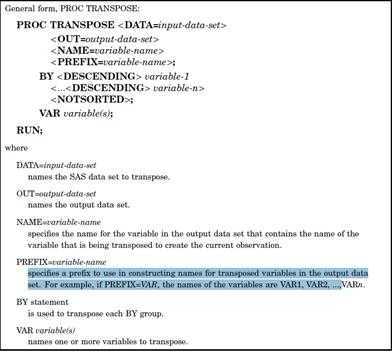标签:style blog http io ar color os sp for
transpose基本语法
Note: If output-data-set does not exist, PROC TRANSPOSE creates it by using the
DATA n naming convention. ??
Note: If you omit the VAR statement, the TRANSPOSE procedure transposes all of
the numeric variables in the input data set that are not listed in another statement. ??
Note: You must list character variables in a VAR statement if you want to transpose
them. ??

被转置后数据集中的默认变量名时啥?
_NAME_:is the default name of the variable that PROC TRANSPOSE creates to identify the source of the values in each observation in the output data set
This variable is a character variable whose values are the names of the variables that are transposed from the input data set
默认标签为:NAME OF FORMER VARIABLE
col1-coln:其余的列都是默认命名
如何改变默认变量名?
The NAME= option specifies a name for the _NAME_ variable
The PREFIX= option specifies a prefix to use in constructing names for transposed variables in the output data set
proc transpose data=sasuser.ctargets out=work.ctarget2 name=Month prefix=Ctarget; run;
改变前后效果如下

by statement对转置数据集进行分组
For each BY group, PROC TRANSPOSE creates one observation for each variable that it transposes. The BY variable itself is not transposed
我的理解:转置后的数据集第一列的值全都是以前的变量名,如果用by后,by变量并不会进行转置,而是在第一列作为分组变量出现,(考虑单个by的情况)第二列才是_NAME_列
对每一个by组都会将以前的变量列出来一遍
var statement
var中的变量是需要进行转置的变量,声明哪些就只会对哪些进行转置,其他don‘t care!
标签:style blog http io ar color os sp for
原文地址:http://www.cnblogs.com/yican/p/3824139.html